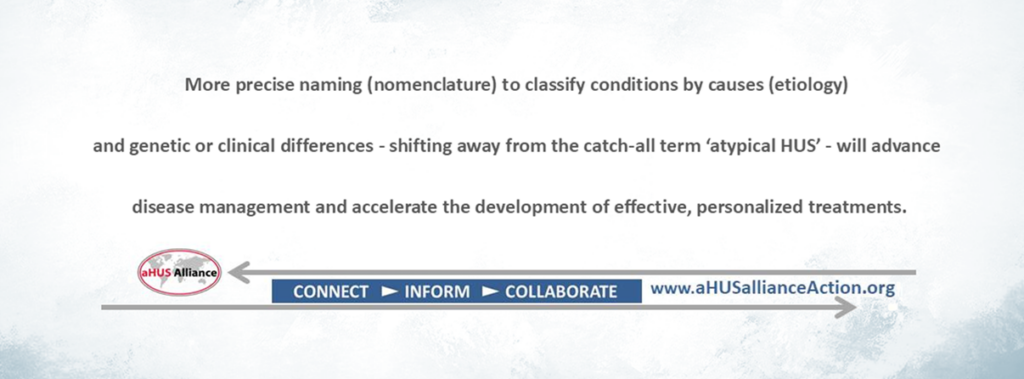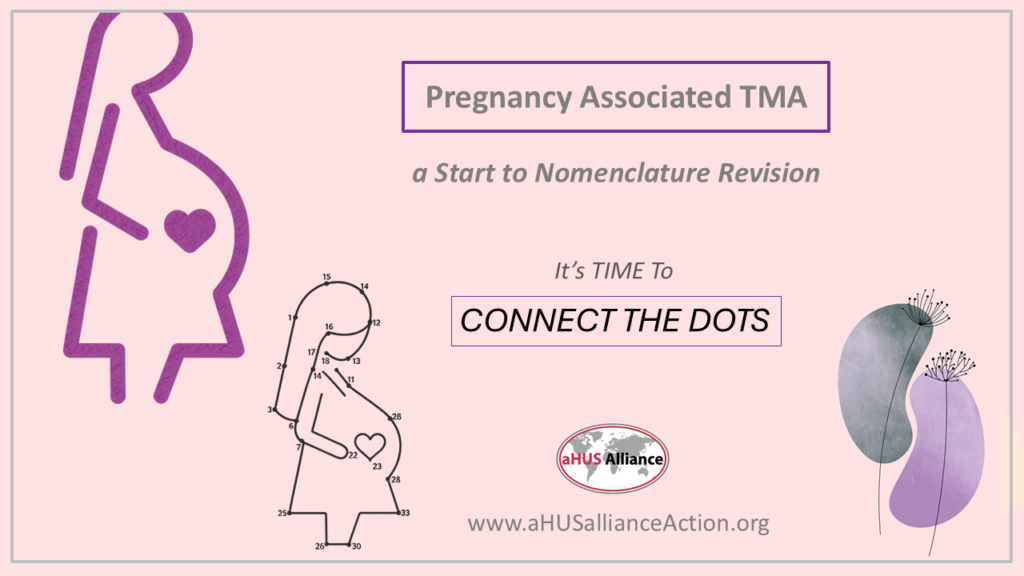It’s amazing how quickly medicine advances. For patients with some diagnoses, it seems like aspects such as new treatments or ‘standard of care’ guidelines can’t move forward quickly enough.
It’s challenging to find information about a medical condition that’s rare, and for the atypical HUS community that’s doubly so since its terminology and key words vary so much. In an interesting twist, the COVID-19 pandemic actually had the silver lining of drawing attention to the effects of thrombotic microangiopathy (TMA), to include systemic damage with microclots negatively impacting organ function. This public awareness has faded somewhat, so the latest research and aHUS clinical trials are difficult to uncover, in part due to lack of consensus for classification and nomenclature among experts.
Atypical HUS is one of the medical conditions grouped under ‘syndromes of thrombotic microangiopathy’ (TMA) which share common characteristics of red blood cell destruction, reduction in platelet counts, and tiny clots which form in small blood vessels to block flow and cause organ damage. Information about atypical hemolytic uremic syndrome is scattered across multiple search terms such as: complement-mediated TMA, primary TMA, familial HUS, or many others. Abbreviations are even more confusing and, without any accepted standards, create fragmented information flow.
Simply put, there are logical reasons why it should be a priority to revise this outdated maze of aHUS/TMA names. More precise naming (nomenclature) to classify conditions by causes (etiology) and genetic or clinical differences – shifting away from the catch-all term ‘atypical HUS’ – will advance disease management and accelerate the development of effective, personalized treatments.

Finding a Starting Point: Pregnancy Associated TMA
As with any difficult task that has a wide scope, the first step is to break it down into manageable chunks. Next, to sort through those segments and determine whether the work must be done in a particular sequence or if efforts can proceed on multiple fronts. That approach is often used for problem-solving, and known as the Bridge Pattern (Article: Applying Bridge Pattern concepts in the aHUS/TMA arena)
High-risk obstetrics, also known as Maternal-Fetal Medicine (MFM), is a subspecialty of obstetrics and gynecology and focused on managing complex pregnancies. These specialists address the medical, surgical, obstetrical, fetal, and genetic complications that can arise during pregnancy. No single test clearly distinguishes atypical HUS from pregnancy-related hypertensive disorders, with clinical overlap for preeclampsia and HELLP share hallmark features which can blur diagnostic clarity. Both aHUS and preeclampsia-related disorders often emerge in the third trimester or postpartum period, contributing further to diagnostic ambiguity. International organizations and experts play a significant role in advancing knowledge and improving care for high-risk pregnancies, as MFM specialists are trained to distinguish between overlapping TMA syndromes and other hypertensive disorders of pregnancy, enabling timely diagnosis and appropriate intervention.
Given the challenges of differentiating TMAs and the various specialists involved with complex care, it makes sense to swiftly settle nomenclature for pregnancy related TMA care as ‘pa-TMA’. Pregnancy associated TMA is recognized and currently being studied by clinician researchers in multiple countries, with cross discipline publications by medical societies including: the Int’l Society of Hematology or American Society of Hematology (ISH or ASH: blood), the Int’l Society of Nephrology or American Society of Nephrology (ISN or ASN: kidney), as well as the Society fo Maternal Fetal Medicine (SMFM: high-risk pregnancies). Not only are MFM specialists are equipped to manage complications such as severe hypertension, renal failure, and coagulopathy, which are often seen in TMA. Coordinated multidisciplinary care can ensure comprehensive management of complex TMA cases, optimizing outcomes for both mother and fetus, and help guide postpartum care including watchfulness for long-term maternal complications.
It makes sense to start the huge task of nomenclature revision in the TMA and aHUS spaces by looking at what’s already currently in place. Atypical HUS and pregnancy has a raft of publications in various medical journals, with physicians and international research teams already assisting peers with expert advice and including TMA on agendas at ‘MedEd’ events. Oddly, these haven’t been connected into a dedicated and more accessible ‘Global Network for Pregnancy Associated TMA’. Simply put, connecting those dots is a good starting point not only for pregnancy related TMA cases but also as an initial step to revise nomenclature by reaching consensus on this point: pa-TMA would encompass all medical conditions where thrombotic microangiopathy is associated with any trimester or the postpartum stage of pregnancy.
Connect the Dots: Like the children’s puzzles which contain a sequence of numbered dots, when drawing a line to connect them reveals the outline of an object, we support taking the existing ‘dots’ of TMA information and groups of experts as a starting point for nomenclature revision.

Revising Nomenclature: a Dilemma is not unique to aHUS
Case in point: Breast Cancer – For decades most people grouped within a general diagnosis termed ‘breast cancer’ followed the same standard of care, which called for removal of tissue often followed by a regime of radiation or chemotherapy. In recent years, as science developed, oncologists were able to better distinguish among subtypes (classification) by detailing specific characteristics and utilizing more precise names (nomenclature). Now those diagnosed with breast cancer may have their physician state whether the cancer has spread (metastasized) or is in one location (in situ), and discuss targeted treatment options which will be best for their situation (e.g. drugs specifically for HER2+ breast cancers).
The situation is very similar for atypical hemolytic uremic syndrome. As we’ve learned more about aHUS over the past decade, it’s even clearer that ‘atypical HUS’ is a general diagnosis. It has different causes (etiologies) which may be genetic or acquired. Originally developed as a catch-all term to indicate patients whose illness did not fall within ‘regular HUS’ characteristics, we’ve continued to lump the remainder of those patients as ‘not regular HUS, as the symptoms are atypical’. In the face of medical advancements, it is both outdated and dangerous to assume a ‘one size fits all’ approach to aHUS patient care. Most cases of atypical HUS fall can be classified as ‘complement mediated’ or having a disease state where the complement system portion of the body’s immune system (which protects the body’s own cells and is our first line of defense against infection) is poorly regulated. Those patients can be treated effectively with therapeutic drugs known as complement inhibitors. But if you’re among the people whose aHUS isn’t due to a fault involving the complement system, an incomplete response and ongoing aHUS activity will lead your medical team to rethink a different type of drug and disease management. Targeting aHUS treatment to individual clinical profiles will yield better outcomes – similar to benefits of a precision medicine approach now commonly used for breast cancer patients.
As with any complex and challenging problem, incorporating new knowledge into existing paradigms isn’t easy. It’s daunting to find a starting point, but for TMA/aHUS nomenclature it seems logical to start with ‘Pregnancy Associated TMA as ‘pa-TMA’ (to avoidany potential confusion with ‘Primary TMA’). Expect refinement of nomenclature for all syndromes of thrombotic microangiopathy to involve many layers, many voices, and many years.
Check out dozens of publications on Pregnancy & aHUS (paTMA) in our ‘Virtual Library‘
CLICK HERE to DIG DEEPER: View our website’s ARTICLES on PREGNANCY

NOMENCLATURE: An Overview of Issues
See More ARTICLES: on Revising NOMENCLATURE

